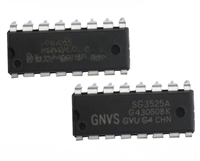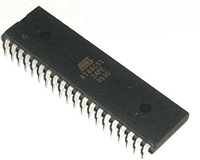AD624
+V
S
NOISE
The AD624 is designed to provide noise performance near the
theoretical noise floor. This is an extremely important design
criteria as the front end noise of an instrumentation amplifier is
the ultimate limitation on the resolution of the data acquisition
system it is being used in. There are two sources of noise in an
instrument amplifier, the input noise, predominantly generated
by the differential input stage, and the output noise, generated
by the output amplifier. Both of these components are present
at the input (and output) of the instrumentation amplifier. At
the input, the input noise will appear unaltered; the output
noise will be attenuated by the closed loop gain (at the output,
the output noise will be unaltered; the input noise will be ampli-
fied by the closed loop gain). Those two noise sources must be
root sum squared to determine the total noise level expected at
the input (or output).
AD624
LOAD
TO
–V
S
POWER
SUPPLY
GROUND
c. AC-Coupled
Figure 31. Indirect Ground Returns for Bias Currents
Although instrumentation amplifiers have differential inputs,
there must be a return path for the bias currents. If this is not
provided, those currents will charge stray capacitances, causing
the output to drift uncontrollably or to saturate. Therefore,
when amplifying “floating” input sources such as transformers
and thermocouples, as well as ac-coupled sources, there must
still be a dc path from each input to ground, (see Figure 31).
The low frequency (0.1 Hz to 10 Hz) voltage noise due to the
output stage is 10 µV p-p, the contribution of the input stage is
0.2 µV p-p. At a gain of 10, the RTI voltage noise would be
2
2
)
10
G
+ 0.2
(
1 µV p-p,
. The RTO voltage noise would be
COMMON-MODE REJECTION
Common-mode rejection is a measure of the change in output
voltage when both inputs are changed by equal amounts. These
specifications are usually given for a full-range input voltage
change and a specified source imbalance. “Common-Mode
Rejection Ratio” (CMRR) is a ratio expression while “Common-
Mode Rejection” (CMR) is the logarithm of that ratio. For
example, a CMRR of 10,000 corresponds to a CMR of 80 dB.
2
)
102 + 0.2 G
10.2 µV p-p,
. These calculations hold for
(
)
(
applications using either internal or external gain resistors.
INPUT BIAS CURRENTS
Input bias currents are those currents necessary to bias the input
transistors of a dc amplifier. Bias currents are an additional
source of input error and must be considered in a total error
budget. The bias currents when multiplied by the source resis-
tance imbalance appear as an additional offset voltage. (What is
of concern in calculating bias current errors is the change in bias
current with respect to signal voltage and temperature.) Input
offset current is the difference between the two input bias cur-
rents. The effect of offset current is an input offset voltage whose
magnitude is the offset current times the source resistance.
In an instrumentation amplifier, ac common-mode rejection is
only as good as the differential phase shift. Degradation of ac
common-mode rejection is caused by unequal drops across
differing track resistances and a differential phase shift due to
varied stray capacitances or cable capacitances. In many appli-
cations shielded cables are used to minimize noise. This tech-
nique can create common-mode rejection errors unless the
shield is properly driven. Figures 32 and 33 shows active data
guards which are configured to improve ac common-mode
rejection by “bootstrapping” the capacitances of the input
cabling, thus minimizing differential phase shift.
+V
S
+V
S
–INPUT
G = 200
AD624
LOAD
100⍀
AD711
V
AD624
OUT
RG
2
TO
–V
S
POWER
SUPPLY
GROUND
REFERENCE
+INPUT
–V
S
a. Transformer Coupled
Figure 32. Shield Driver, G ≥ 100
+V
S
+V
S
–INPUT
RG
1
AD712
100⍀
100⍀
AD624
V
AD624
OUT
LOAD
RG
–V
S
2
REFERENCE
+INPUT
TO
–V
S
POWER
SUPPLY
GROUND
–V
S
Figure 33. Differential Shield Driver
b. Thermocouple
REV. C
–9–






 SG3525资料手册详解:SG3525参数分析、引脚说明、应用介绍
SG3525资料手册详解:SG3525参数分析、引脚说明、应用介绍

 AT89C51单片机资料手册详细解析及应用示例
AT89C51单片机资料手册详细解析及应用示例

 CP2102资料手册解读:CP2102引脚说明、关键参数分析
CP2102资料手册解读:CP2102引脚说明、关键参数分析

 资料手册解读:UC3842参数和管脚说明
资料手册解读:UC3842参数和管脚说明
